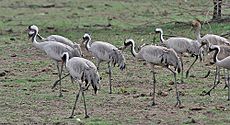Crane (bird) facts for kids
Cranes are tall, wading birds that belong to the family Gruidae. There are 15 different types, or species, of cranes. The tallest crane is the sarus crane, which can stand as tall as 1.8 meters (about 6 feet)!
Cranes might look like herons, but they are usually bigger. They often have a partly bare head and a stronger bill. When cranes fly, their long necks stretch out in front, and their legs trail behind them.
The oldest crane fossils were found in North America. Today, cranes live all over the world, except in Antarctica and South America. Sadly, many crane populations are endangered because of hunting and their homes being destroyed.
Quick facts for kids Cranes |
|
|---|---|
 |
|
| Common cranes (Grus grus) in Rajasthan | |
| Scientific classification | |
| Kingdom: | |
| Phylum: | |
| Class: | |
| Order: | |
| Family: |
Gruidae
|
| Genera | |
|
|
Contents
Discovering Cranes: Appearance and Size
Cranes are known for their long legs and tall bodies. They are usually brown, white, or gray in color. There are more than 15 different kinds of crane species.
The whooping crane (Grus americana) is the tallest bird in America. Adult whooping cranes can stand 5 feet (about 1.5 meters) tall. Their wingspan can reach up to 7 feet (about 2.1 meters) wide.
Crane Life: Diet, Habits, and Sounds
Cranes are omnivores, which means they eat both plants and animals. Their diet includes many kinds of plants, reptiles, small mammals, and other birds. A crane usually lives for about 20 to 25 years.
Cranes are very social birds and often live in large flocks. In some parts of Asia, especially Japan, certain crane species are considered holy birds.
How Cranes Reproduce
Cranes typically build their nests in marshy areas. They usually lay two eggs at a time. Cranes are known for making loud sounds that can be heard from far away.
When cranes are ready to mate, they perform special dances. These dances include quick steps, high leaps, stretching, and bowing. Baby cranes, called chicks, grow very quickly. They develop their flight feathers when they are two to four months old. Cranes are very vocal and use many different types of calls to communicate. They also use their bodies to send messages to each other.
Crane Behavior and Self-Defense
All cranes are quite good at defending themselves. They are usually large birds and can peck, kick, and hit opponents with their wings. Cranes are also territorial, meaning they protect their space. Males will fight even more strongly during mating seasons. Zookeepers sometimes use clear shields to protect themselves from crane attacks.
The History of Cranes: Evolution
Cranes are an ancient type of wading bird. The first clear fossils of cranes come from the Eocene epoch. Their closest relatives are the rails (family Rallidae), which are also in the order Gruiformes. Most other groups in the Gruiformes are birds that cannot fly. These birds lived in forests, so we have very few fossils of them.
Protecting Cranes: Threats and Conservation
The biggest dangers to cranes are hunting and the destruction of their habitat. Cranes need large areas to live and thrive. Because of these threats, all cranes are protected by international agreements.
Related pages
- Grus
- Blue crane
- Black-necked crane
- Common crane
- Grey crowned crane
- Red-crowned crane
- Sandhill crane
- Sarus crane
- Siberian crane
Images for kids
-
The bare skin on a sandhill crane's face can change color or expand when the bird is excited.
-
The long, coiled trachea that helps the sarus crane make its loud trumpeting calls.
-
Demoiselle cranes in Mongolia. These birds migrate to Northern India in winter.
-
Common cranes in Israel. Many crane species gather in large groups during migration.
-
A Grey crowned crane at Martin Mere, UK.
-
"Departure of Cranes," an oil painting by Józef Chełmoński from 1870.
-
Dwarves fighting cranes in northern Sweden, from a 16th-century drawing.
See also
 In Spanish: Grullas para niños
In Spanish: Grullas para niños



















